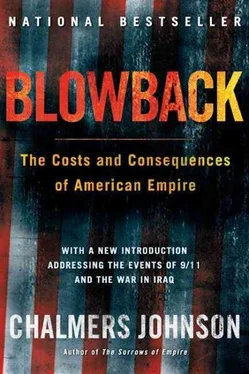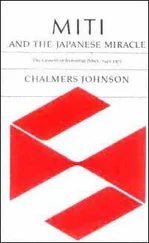Chalmers Johnson - Blowback, Second Edition - The Costs and Consequences of American Empire
Здесь есть возможность читать онлайн «Chalmers Johnson - Blowback, Second Edition - The Costs and Consequences of American Empire» весь текст электронной книги совершенно бесплатно (целиком полную версию без сокращений). В некоторых случаях можно слушать аудио, скачать через торрент в формате fb2 и присутствует краткое содержание. Год выпуска: 0101, ISBN: 0101, Издательство: Macmillan, Жанр: Старинная литература, на английском языке. Описание произведения, (предисловие) а так же отзывы посетителей доступны на портале библиотеки ЛибКат.
- Название:Blowback, Second Edition: The Costs and Consequences of American Empire
- Автор:
- Издательство:Macmillan
- Жанр:
- Год:0101
- ISBN:9780805075595
- Рейтинг книги:5 / 5. Голосов: 1
-
Избранное:Добавить в избранное
- Отзывы:
-
Ваша оценка:
- 100
- 1
- 2
- 3
- 4
- 5
Blowback, Second Edition: The Costs and Consequences of American Empire: краткое содержание, описание и аннотация
Предлагаем к чтению аннотацию, описание, краткое содержание или предисловие (зависит от того, что написал сам автор книги «Blowback, Second Edition: The Costs and Consequences of American Empire»). Если вы не нашли необходимую информацию о книге — напишите в комментариях, мы постараемся отыскать её.
Blowback, Second Edition: The Costs and Consequences of American Empire — читать онлайн бесплатно полную книгу (весь текст) целиком
Ниже представлен текст книги, разбитый по страницам. Система сохранения места последней прочитанной страницы, позволяет с удобством читать онлайн бесплатно книгу «Blowback, Second Edition: The Costs and Consequences of American Empire», без необходимости каждый раз заново искать на чём Вы остановились. Поставьте закладку, и сможете в любой момент перейти на страницу, на которой закончили чтение.
Интервал:
Закладка:
The global economic crisis that began in 1997 in East Asia and subsequently spread elsewhere threatens China almost as much as other Asian nations. But there are several factors in the Chinese situation that leave it in a more advantageous position than many other developing nations. As a start, the country is insulated from currency speculators because its currency is not freely traded on world markets. A year after the crisis began Malaysia, one of East Asia’s earliest-stricken economies, in order to regain control over its own economic affairs, took a page out of China’s book and imposed controls over capital flows so that foreign speculators could no longer freely bring in or take out huge amounts of Malaysian currency. China has one of the highest levels of external debt in the world, of around $120 billion; but more than 85 percent of that debt is in medium- and long-term loans, not the short-term ones that bankrupted South Korea, Thailand, and Indonesia when international lenders began demanding immediate repayment. Most foreign investment in China is also in major manufacturing projects, not in stocks, so there is less danger of sudden capital flight. In addition, China holds the world’s second-largest foreign currency reserves (after Japan), around $130 billion, which exceed its external debt.
China’s main structural weakness is its banking system. The People’s Bank of China estimated that during 1997 at least 22 percent of the nation’s loans, worth more than $200 billion, were nonperforming—that is, they were not being repaid. The borrowers of these funds are the one hundred thousand sometimes woefully inefficient and unprofitable state-owned enterprises left over from the Maoist era, which together employ some fifty-six million people. These companies are the main legacy of the old Soviet-type economic system that the Communists adopted in the 1950s. In 1996, the state-owned sector turned in an overall loss for the first time. By contrast, collective enterprises, owned by local political units but subject to market forces, have doubled their productivity since 1978, while the privately owned sector now accounts for more than 11 percent of all Chinese industrial output.
At the 15th Congress of the Chinese Communist Party, held in September 1997, the party launched a new drive to transform the majority of state-owned enterprises into share-holding or limited-liability companies. If they remain unprofitable, they can then be closed one by one. Zhu Rongji was appointed prime minister primarily to manage this delicate operation, endangering as it does the previously guaranteed lifetime jobs of so many workers. His main problem has been that if he restricts bank credit to state-owned enterprises in order to rehabilitate the banking system, he risks soaring unemployment when many such enterprises go under. Despite the “no pain, no gain” ideology being urged on China by the Western business press, officials are proceeding very slowly with these changes, for overzealous liquidation of state-owned enterprises, with its ensuing massive unemployment and dislocation, could destabilize the entire society. In July 1998, as part of the effort to reform the old economic structure, President Jiang Zemin ordered the People’s Liberation Army to liquidate the fifteen thousand commercial enterprises it runs, often of much greater interest to officers and troops than military preparedness. A distinctive characteristic of the Chinese economy has long been the extensive business activities of the armed forces (and the widespread corruption that has followed in their wake). Intended to increase the competitiveness of state-owned enterprises by stamping out corruption and smuggling, getting the army out of business will not be easy.
China’s long-range economic strategy is to transform its state-owned enterprises into versions of Japan’s industrial groups, the zaibatsu (renamed keiretsu after the war), or South Korea’s chaebol (which, unlike Japan’s groups, are more likely to be family-owned). By grouping profitable and risky enterprises together into developmental conglomerates and supplying bank credit to them on a preferential basis, China hopes to forge its own versions of Mitsubishi, Sumitomo, Daewoo, and Samsung. Needless to say, this will divide the labor force into labor aristocrats working for strategic corporations and ordinary workers in medium and small enterprises who sell intermediate goods to the big companies. This structural feature has long inhibited labor solidarity in Japan and South Korea, and it will have the same effect in China. While American economic theorists generally disapprove of the zaibatsu-type of corporate organization, something Japan invented in the late nineteenth century, the postwar descendants of the original zaibatsu were crucial to the economic development of Japan, South Korea, and Taiwan. China has every reason to try to emulate them.
The real economic model for mainland China, although never mentioned for all the obvious reasons, is undoubtedly neither Japan nor South Korea but Taiwan, where the state and the ruling Nationalist Party own outright or directly control about 50 percent of all corporate assets and account for close to 30 percent of Taiwan’s gross national product. Numerous and successful state-owned enterprises are the single most striking feature of Taiwan’s economic landscape. Even though one of the richest places on earth, largely untouched by the economic meltdown of the late 1990s, it is structurally less orthodox in terms of the American model of capitalism than any other East Asian country. 8
But Taiwan is not just a covert economic model for China; it is also one of China’s greatest political conundrums. Although an unquestioned part of China according to international law, the island has become so rich that many of its inhabitants would far rather see their country secede and become independent than find themselves integrated into the poorer, more politically repressive mainland. If Taiwan did declare its independence, any number of dreadful developments could follow, ranging from a nationalistic backlash in China that could lead to the overthrow of the regime to an attempted invasion of Taiwan to keep China’s territory intact and a possible larger war involving the United States. The Taiwan problem at the end of the twentieth century is, as it was at the midpoint of the century, still the single most complicated issue of Chinese foreign policy and the most dangerous place where Chinese and American interests intersect. If it is mishandled by either side, the various kinds of blowback that might result could dominate global politics in the next century.
CHINA: FOREIGN POLICY,
HUMAN RIGHTS, AND TRADE
In addition to its desire to maintain national security, advance its economic interests, and repress dissidents, China’s ruling Communist Party emphatically plays upon the country’s experience as a victim of imperialism and on its newfound nationalism. In its foreign policy, its primary focus has not been on expanding its territory or influence at the expense of other nations but on settling old, irredentist claims. The term “irredentism” derives from the name of an Italian political party of 1878 that sought to recover adjacent regions inhabited largely by Italians but under foreign control; by extension it now refers to any policy aimed at recovering territories lost to foreigners.
In the Chinese context irredentism applies to places formerly claimed by Imperial China, whose last dynasty ended in 1912, and allegedly lost due to foreign activity. Without regard to their relative importance, the primary ones in question have long been 1) Hong Kong, 2) Taiwan, 3) various island groups in the South China Sea, and 4) Tibet. The issues surrounding these contested areas have varied depending on whether each was occupied by China or others, on the nature of the historical record that lay behind each claim, and on the relative power of the claim holders. In addition, there is the question, seldom directly raised by the Chinese but to one degree or another taken into consideration, of the costs today of pursuing old claims, no matter how well founded. Each of the remaining claims—the Hong Kong one having been peaceably settled in 1997—is much exacerbated by the regime’s increasing reliance on nationalism to solidify a base of support for its rule. The need to invoke the inviolable nature of “the Chinese motherland” as a basis for power has spurred the government to right old wrongs even when doing so violates another nation’s sovereignty or tramples on the human rights of peoples who were never in any sense part of the Chinese empire. This is only complicated by China’s stated willingness to use military means to achieve its irredentist aims.
Читать дальшеИнтервал:
Закладка:
Похожие книги на «Blowback, Second Edition: The Costs and Consequences of American Empire»
Представляем Вашему вниманию похожие книги на «Blowback, Second Edition: The Costs and Consequences of American Empire» списком для выбора. Мы отобрали схожую по названию и смыслу литературу в надежде предоставить читателям больше вариантов отыскать новые, интересные, ещё непрочитанные произведения.
Обсуждение, отзывы о книге «Blowback, Second Edition: The Costs and Consequences of American Empire» и просто собственные мнения читателей. Оставьте ваши комментарии, напишите, что Вы думаете о произведении, его смысле или главных героях. Укажите что конкретно понравилось, а что нет, и почему Вы так считаете.










